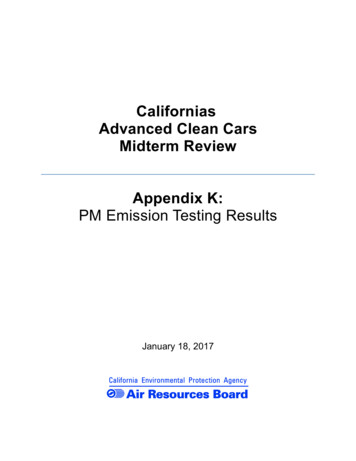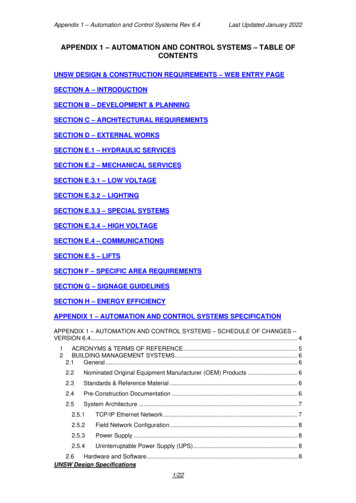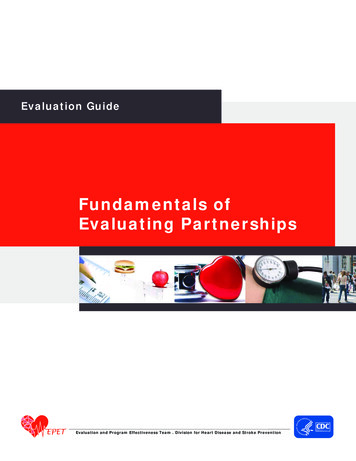
Transcription
CaliforniasAdvanced Clean CarsMidterm ReviewAppendix K:PM Emission Testing ResultsJanuary 18, 2017
TABLE OF CONTENTSI. Introduction . 1II. Test Procedures and Test Methods . 1Driving Cycles . 2Federal Test Procedure Driving Cycle . 2II.A.1 Supplemental Federal Test Procedure (SFTP or US06) driving cycle . 3II.A.2 Selection of Vehicles . 4III. Test Results: . 6Summary and Analysis of Gravimetric Test Results . 6III.B Real time Measurement Summary and Analysis .11III.C Summary of BC results .14III.D Variability .16IV. Summary of Results .19V. References .20VI. Attachment: All test results .21LIST OF FIGURESFigure 1 - The FTP test cycle speed trace. 3Figure 2 - US06 speed trace . 4Figure 3 - F-150 GPF Configuration .10Figure 4 - Malibu Underfloor Catalyzed GPF .10Figure 5 - 2015 Mazda 3 GDI emissions on FTP cycle.12Figure 6 - 2015 Subaru BRZ GDI/PFI over the FTP cycle. .13Figure 7 - 2015 Honda Accord on US06 cycle.14Figure 8 - Correlations between PM mass and black carbon emissions on the FTP cycle .15Figure 9 - Example of US06 variability with the same vehicle and driver .17Figure 10 - Example of US06 variability with calculated load and throttle position data. .19LIST OF TABLESTable 1 - Overview of low-GHG engine technologies tested. 5Table 2 - Summary of PM mass results from vehicles tested at CARB . 6Table 3 - GPF Emissions Results.11Table 4 - CO2 Emissions Analysis for GPFs .11Table 5 - Standard deviations over FTP and US06 cycles .16Table 6 - Full PM test results.21K - ii
I. IntroductionTo assess the particulate matter (PM) emissions of currently available low greenhouse gas(GHG) emitting engines, a vehicle testing campaign was conducted at the California AirResources Board. Vehicles were chosen to represent a variety of low-GHG technologies,particularly targeting newer engines that were expected to have powertrains representative offuture technologies. These engines may have undergone recent revisions that likely wouldhave considered compliance with the upcoming 3 mg/mi PM standard. Staff tested vehicles andconducted gravimetric PM emission measurements to look at mass emission levels during thecertification driving cycles and real time PM emissions measurements to qualitatively determinewhere in the driving cycle PM emissions occur. A total of 15 vehicles were tested and theresults of the testing are summarized in this appendix.II. Test Procedures and Test MethodsTesting was conducted in light-duty test cells at the ARB Haagen-Smit Laboratory (HSL) in ElMonte, California. Each test cell is equipped with a 48-inch single-roll electric chassisdynamometer, a constant volume sampler (CVS), and one or more PM2.5 sampling systems thatmeet requirements defined by 40 CFR Part 1065. The PM gravimetric analyses meet therequirements in 40 Code of Federal Regulations (CFR) Part 1066, and followed the approvedgravimetric analysis and filter media handling techniques. 1,2,3The typical CVS flowrate of the federal test procedures (FTP) test cycle at ARB is 350 standardcubic feet per minute (scfm). The test fuel was California Phase III certification-grade gasolinecontaining 10% ethanol.Real time PM emission measurements were also drawn from the CVS tunnel near where thePM mass samples were drawn. Real time instruments were operated according to eachinstrument’s manufacturer protocol. Solid particle number (SPN) was measured with a PMPcompliant method (d50 of 23nm) using either a Horiba Solid Particle Counting System (MEXA2000 SPCS) or AVL solid particle counter (489 APC), both of which consist of a volatile particleremoval unit and a Condensation Particle Counter (CPC). Black carbon (BC) was measuredwith an AVL Micro Soot Sensor (MSS 483), which quantifies BC with photoacousticspectroscopy at 808nm. SPN measurements were recorded at 1 Hz frequency and BCmeasurements at 1 Hz or higher frequency. Additional PM metrics from TSI Engine ExhaustParticle Sizers (EEPS) and either TSI or Grimm CPC were also collected, but are not includedin this document.ARB, 2016a. California Air Resources Board. SOP MV-AEROSOL-145 v5.3. June 2015.https://www.arb.ca.gov/testmeth/slb/sop145v5 3.pdf2 ARB, 2016b. California Air Resources Board. SOPs MV-AEROSOL-156. January 2016.https://www.arb.ca.gov/testmeth/slb/sop156 xrf v2 0.pdf3 ARB, 2016c. California Air Resources Board. SOPs MV-AEROSOL-158. October pdf1K-1
On-board diagnostics (OBD) data was also collected from most vehicles tested. Some of theparameters that were collected include vehicle speed, engine speed, lambda ratios, mass airflow, calculated load values, cylinder 1 advance timing, and throttle and accelerator positions.PM mass tunnel blanks (filtered dilution air sampled at the end of the CVS) were collectedregularly and were generally equivalent to 0.1 mg/mile. One higher-emitting vehicle, a Ford F150, which was tested with tunnel blanks that reached up to approximately 0.5 mg/mi, as notedin the testing results below. Earlier work has measured tunnel blank values of 2 x 109particles/km for SPN and 0.15 mg/mile for BC. 4,5Driving CyclesLDV PM emission standards are tied to specific driving cycles on a chassis dynamometer. Thedriving cycle is intended to represent a specific duty or activity of a vehicle during its operation.The two most relevant drive cycles for LDV PM emission standards are the standard FederalTest Procedure (FTP) cycle and the high speed, high acceleration portion of the SupplementalFTP (SFTP or US06).Emission tests results presented later will be given primarily for these two cycles. Somevehicles were also tested on other cycles for research purposes. The California Unified Cycle(UC) was also used and it was originally developed by ARB for use in inventory modeling ofemissions from light-duty vehicles. The Worldwide Harmonized Light Duty Test Cycle (WLTC)is of interest for comparison to European vehicle emission standards. However, testing done onthe WLTC was done using FTP methods, not Worldwide Harmonized Light Vehicles TestProcedures (WLTP) methods, for determining vehicle test weights and road loads so the resultsare not directly comparable to testing done in accordance with the official WLTP requirements.For some vehicles, the Highway test cycle was also used. However, the test results for cyclesother than the FTP and US06 are not analyzed because the data was limited and was forresearch purposes.Federal Test Procedure Driving CycleThe FTP consists of two urban dynamometer driving schedules (UDDS) run in series (Figure 1).Each UDDS is divided into two phases, with a start phase running for 505 seconds and astabilized phase running for an additional 864 seconds. The first UDDS is considered a coldstart test because the engine is started in a “cold” condition after an overnight engine off ‘soak’period. The second UDDS is considered a hot start test because it begins with a “hot” enginefrom a car that has been sitting with the engine off for 10 minutes after the first UDDS ends.The stabilized phase in both UDDS cycles is assumed to have the same emissions; therefore, itis typically not run after the hot start. This “three-phase” driving schedule is commonly referredARB, 2012. California Air Resources Board. “LEV III Appendix P. Technical Support Document: Development ofParticulate Matter Mass Standards for Future Light-Duty Vehicles”. January 012/levappp.pdf5 Kamboures, 2013. Kamboures, M. A., et.al. . (2013). “Black Carbon Emissions in Gasoline Vehicle Exhaust: aMeasurement and Instrument Comparison”. Journal of the Air and Waste Management Association 63, 886-901.4K-2
to as an FTP-75. The FTP-75 has a total distance travelled of 11.04 miles, an average speed of21.2 miles per hour (mph), and a total duration of 1874 seconds. The emission result is aweighted average where the cold start and stabilized phase (the first UDDS cycle) is weightedat 43 percent and the hot start and stabilized phase (equivalent to the second UDDS) isweighted at 57 percent.Figure 1 - The FTP test cycle speed trace 6II.A.1 Supplemental Federal Test Procedure (SFTP or US06) driving cycleThe US06 was developed to reflect aggressive, high speed, and high acceleration drivingbehavior. The US06 driving cycle is shown in Figure 2. It is a hot start test typically run with aprep cycle to ensure the car is warmed up; the US06 test immediately follows the prep cyclewithout an engine off or restart. The US06 cycle represents an 8.01 mile route with an averagespeed of 48.4 mph, maximum speed of 80.3 mph, maximum acceleration rate of 8.46 mph/sec,and duration of 596 seconds. The higher acceleration rates and speeds of the US06 cycle leadto higher engine loads, which historically often led to higher PM emission rates.6 EPA,2016a. US Environmental Protection Agency. “Emission Standards Reference Guide for On-road and Nonroad Vehicles and Engines”. August 2016. tmK-3
Figure 2 - US06 speed trace 7II.A.2 Selection of VehiclesAs discussed in Appendix J, the light duty vehicle fleet is moving towards gasoline directinjection (GDI) technology to comply with the Low Emission Vehicle (LEV III) greenhouse gas(GHG) standards. GDI technology was of particular concern in terms of PM emission impactswhen the more stringent standards were first adopted in 2012. Test results from early GDIequipped engines showed significantly higher PM emissions than conventional port-fuel injector(PFI) systems. The 3 mg/mi PM emission standard for the FTP starts phasing in 2017 and willbe fully implemented by 2021. Some manufacturers have already redesigned their engines tomeet this standard. The US06 PM standard of 6 mg/mi starts phasing in 2017 for vehiclescomplying with the 3mg/mi FTP standard and will be fully implemented by 2021. However,vehicles in 2017 and 2018 will be certified to interim higher standards of 10 mg/mi for the US06.Given the rapidly increasing fraction of the fleet utilizing GDI equipped engines, testing for thisprogram primarily targeted GDI engines. The chosen technologies included:–Atkinson cycle GDI–Dual PFI/GDI systems–Downsized turbocharged GDI–GDI with Piezo injectors–GDI plug-in hybrid electric vehicles (PHEV)–PFI hybrid or PHEVTable 1 summarizes the vehicles tested and corresponding engine technologies, including fuelinjection, turbocharging, engine displacement, model year, and improved control strategies.EPA, 2016b. US Environmental Protection Agency. “Dynamometer Drive Schedules US06”. April s-testing/dynamometer-drive-schedules7K-4
Table 1 - Overview of low-GHG engine technologies testedEngine technologycategoryModelyearMakeModelEngineAtkinson cycle GDI,high compression ratio,small displacement2015Mazda32.0L SkyActiv2012LexusIS3503.5L 2GR-FSE2015SubaruBRZ2.0L2016ToyotaTacoma3.5L Atkinson V62015FordF-1502.7L turbo2014FordFiesta1.0L turbo2014MiniCooper2.0L turbo2016VWJetta1.4L turboDownsizedturbocharged GDI withPiezo injectors2014DaimlerCLA 2502.0L turboGDI yVolt1.4L2013ToyotaPrius Plug-in1.8L2016ToyotaPrius1.8LHyundaiSonata Plugin2.0LPFI GDI systemsDownsizedturbocharged highBMEP GDIPFI Hybrid/PHEVGDI PHEV2016K-5
III. Test Results:Summary and Analysis of Gravimetric Test ResultsA total of 15 vehicles were tested, of which 9 were GDI vehicles, 3 were dual GDI/PFI systems,and 3 were PHEV with PFI.Average and individual test results for each vehicle for FTP-75 and US06 are presented inTable 2. In general, each vehicle was tested at least three times for FTP and US06, but due tooccasional sampling or analysis issues, not all tests have valid PM mass measurements.Table 2 - Summary of PM mass results from vehicles tested at CARBFTPUS06Average Indiv. testAverageIndiv.SD MassVehicleMassMassMasstest 5 Mazda 31.650.900.581.460.192.0 liter GDI1.580.364,000 miles1.290.595.551.282012 Lexus IS3505.781.355.641.323.5 liter GDI PFI0.295.2940,000 miles5.950.911.892015 Subaru BRZ0.963.072.0 liter GDI PFI0.210.794.3215,000 miles1.193.000.341.972016 Toyota Tacoma0.402.263.5 liter GDI PFI0.420.051.4651,000 mi0.433.365.08*3.44*5.63*7.34*4.53*2.53*2015 Ford F150*2.7 liter turbo GDI6.762.86*5.50*3.91*0.9515,000 mi5.02*1.61*4.571.011.321.521.672014 Ford Fiesta1.411.361.0 liter turbo GDI1.420.231.2126,000 miles1.561.371.551.22K-6SD Mass(mg/mi)0.230.051.220.981.910.18
2014 Mini Cooper2.0 liter turbo GDI28,000 mi0.432016 VW Jetta TSI1.4 liter GDI turbo5,000 mi, L2ULV0.282014 Mercedes CLA2.0 liter GDI turbo30,000 mi, L2ULV0.282016 Chevy Malibu2.5 liter GDI18,000 mi, ULEV2016 Honda Accord2.4 liter GDI27,000 mi2013 Chevy Volt1.4 liter PHEV PFI8,000 mi2013 Toyota Prius1.8 liter PHEV PFI25,000 mi2016 Toyota Prius1.8 liter HEV PFI5,000 1.121.05* Ford F-150 was tested in a CVS tunnel with higher tunnel blanks of up to 0.5 mg/mi2016 Hyundai Sonata2.0 liter PHEV GDI6,000 miMost of the vehicles tested were under 1.5 mg/mi over the FTP cycle, which is significantly lessthan earlier fleets of GDI vehicles. 8 The three major exceptions with higher emissions were the2012 Lexus IS350, the 2015 Chevrolet Malibu, and the 2015 Ford F-150. All three of these8ARB, 2012.K-7
vehicles had very high cold start emissions, which accounted for the majority of the total FTPemissions.The 2015 Mazda 3 with an Atkinson cycle GDI engine emitted 1.5 mg/mi over the FTP cycle,but US06 emissions were very well controlled at 0.6 mg/mi. As with many GDI vehicles,emissions were cold start dominant, although at a significantly lower level than earliergeneration GDI vehicles.The Lexus IS350 was an early implementation of a dual GDI/PFI systems, and calibration maynot have targeted low PM emissions for the 2012 model year – although emissions were over 5mg/mi, these results were not atypical for GDI engines at the time. Like many earlier GDIvehicles, the majority of these emissions were on cold start, and US06 emissions (with no coldstart) were significantly lower at 1.3 mg/mi.It is worth noting that more recently introduced GDI/PFI engines such as the 2015 Subaru BRZand 2016 Toyota Tacoma, were much lower emitting on the FTP just a few model years later.The Toyota Tacoma, in particular, was very low emitting with average FTP emissions below 0.5mg/mi while the Subaru BRZ emitted an average of 1.0 mg/mi over the FTP cycle. However,both of these more recent GDI/PFI vehicles were found to have US06 emissions that werehigher than many of the GDI only vehicles tested in this campaign, a characteristic which ismore similar to a conventional PFI only vehicle.The Ford F-150 with a 2.7-liter turbocharged GDI engine was also measured at over 5 mg/miover the FTP cycle, once again with the vast majority of emissions occurring during cold start.In this case, the catalyst light-off strategy and calibration used by Ford for this particular vehiclemay have traded off higher PM emissions for quicker catalyst light off to minimize hydrocarbonand oxides of nitrogen emissions as staff observed indications that the vehicle remained inand/or returned to a modified spark timing and engine speed strategy commonly associated witha catalyst light-off strategy even after the completion of the first hill on the FTP. This vehiclewas tested in a CVS tunnel with higher tunnel blanks, equivalent of up to 0.5 mg/mi, but theoverall emissions were significantly higher than the tunnel blanks. This vehicle was also testedwith a prototype GPF as described below, which was tested in a CVS tunnel with near-zerotunnel blanks.Like the Ford F-150, the Ford Fiesta was equipped with a downsized, turbocharged GDI‘EcoBoost’ Ford engine. However, the small displacement 1.0-liter engine in the Fiesta wasfound to have much lower PM emissions especially at cold start, with an average of 1.4 mg/miover both the FTP and US06 cycles which appears to be more representative of the newer GDIfleet. This vehicle was also equipped with a small close-coupled catalytic converter that waslocated close to the exhaust manifold and the vehicle appeared to rely less on an extended useof a catalyst light-off strategy like the F-150.The 2014 Mini Cooper S is equipped with a 2.0 liter direct injected turbocharged engine andresults show emissions were very well controlled on the FTP at 0.4 mg/mi and slightly higher onK-8
the US06 at 1.2 mg/mi. As with many other well-controlled GDI vehicles, the Mini showed goodcontrol over all portions of the FTP cycle, with somewhat higher emissions during cold start.The 2016 Volkswagen Jetta and 2014 Mercedes CLA were the lowest emitting GDI vehiclestested, both averaging 0.3 mg/mi over the FTP cycle. As with the Honda Accord, both the VWand Mercedes appear to have very well controlled PM emissions on cold start. The Mercedes,which is equipped with Piezo fuel injectors, also had very low US06 emissions at 0.3 mg/mi.The VW Jetta averaged 1.0 mg/mi over the US06 cycle.The 2016 Chevrolet Malibu emissions were more similar to the earlier GDI fleet, with FTPemissions of 7.0 mg/mi and US06 emissions of 2.1 mg/mi. As with the 2012 Lexus, a majorproportion of the PM emissions occurred during cold start. This vehicle was also tested afterbeing retrofit with a prototype GPF as described below.Although the 2015 Honda Accord is the same model year, naturally aspirated and similardisplacement to the Chevy Malibu, FTP emissions were significantly lower for the Accord at anaverage of 0.9 mg/mi. The difference appears to be due especially to much lower PMemissions on cold start with the Honda. US06 emissions were only moderately lower at 1.3mg/mi versus 1.6 mg/mi for the Chevy Malibu.A total of four hybrid electric vehicles were tested, the 2013 Chevrolet Volt, 2013 Toyota Priusand 2016 Hyundai Sonata were PHEVs tested in charge sustaining mode to mimic aconventional HEV. The 2016 Toyota Prius was a conventional HEV. The two Priuses and theVolt were equipped with PFI systems and were very low emitting over both test cycles. The PFIhybrids were found to have average mass emissions of no higher than 0.3 mg/mi over both FTPand US06 cycles. The fourth PHEV vehicle tested, a 2016 Hyundai Sonata, was equipped witha GDI engine and resulted in emissions more similar to other current GDI vehicles at 1.1 mg/miover the FTP cycle and 1.6 mg/mi over the US06.Staff also tested prototype gasoline particulate filters (GPFs) for controlling PM emissions. Thistechnology appears capable of meeting the future 1 mg/mi standard, even for particularlychallenging engines. For this testing, two newer GDI engines were selected that had gonethrough a partial redesign cycle, but would not yet readily meet the 3 mg/mile standard. Thetwo vehicles selected were the 2015 Ford F-150 and 2016 Chevrolet Malibu, with emissionrates of 5.6 mg/mi and 7 mg/mi respectively over the FTP cycle. Both vehicles were retrofit withcatalyzed GPFs that replaced the second catalyst in the exhaust stream. On the F-150, thiscatalyst is housed in the same can as the first converter (see Figure 3) while on the Malibu, it ismounted in a typical underfloor position (see Figure 4).K-9
Figure 3 - F-150 GPF ConfigurationFigure 4 - Malibu Underfloor Catalyzed GPFWithout the GPF, both vehicles had fairly high FTP PM emissions and would need furtherimprovements to meet the 3 mg/mi standard. The emission reductions from GPF testing areshown in Table 3. On the FTP, an 88% reduction was observed for both vehicles and broughtK - 10
emissions to a level below 1 mg/mi. The effectiveness of the GPFs on the US06 weresomewhat lower, reducing PM emissions by 72% and 54% respectively for the F-150 andMalibu. The results from both vehicles show that GPFs are an effective control technology tomeet future 1 mg/mi PM standards, even for vehicles that are substantially higher in PMemissions.Table 3 - GPF Emissions ResultsDescriptionAverage of FTP(mg/mi)Average ofUS06 (mg/mi)2015 FORD F1505.53.92015 FORD F150 W/GPF0.61.12016 CHEV MALIBU7.02.12016 CHEV MALIBU W/GPF0.80.9FTP GPFEffectiveness(%)US06 GPFEffectiveness(%)88%72%88%54%As part of the GPF testing, CO2 and gaseous pollutant emissions were also measured, with theCO2 results tabulated in Table 4. While the data shows a slight decrease in CO2 emissions, themagnitude is within the typical driver and measurement variability, particularly as testing wasdone with different drivers and in different test cells. These results confirm that the increasedbackpressure from the GPF, even in a retrofit application, did not have a significant impact onCO2 over the FTP and US06 cycles. In addition, gaseous pollutant emissions were generallyequivalent or better than the stock exhaust configuration.Table 4 - CO2 Emissions Analysis for GPFsAverage ofAverage of FTPDescriptionUS06 CO2CO2 (g/mi)(g/mi)2015 FORD F1503914762015 FORD F150386455W/GPF2016 CHEV333321MALIBU2016 CHEV330314MALIBU W/GPFFTP PercentCO2 increaseUS06 PercentCO2 increaseNANA-1%-4%NANA-1%-2%III.B Real time Measurement Summary and AnalysisWhile not an equivalent substitute to gravimetric analysis for accurately determining PM mass,real time measurements allowed an investigation of when PM emissions were occurring withinthe test cycles. While PM emissions are generally known to be generated primarily during coldstart or under high engine load, which held true for the vehicles tested in this program, theK - 11
emission profiles varied. For many of the tested GDI vehicles, the overall FTP emissions weredominated by cold start while high engine speed/load transients were well controlled. Thesevehicles generally resulted in higher FTP emission results, but lower US06 emission results. Atthe other extreme were vehicles with low cold start emissions, but with higher emissions underhigh load, which was most common with some of the combination GDI/PFI vehicles and is asimilar trend to results from traditional PFI system vehicles.An example of a cold-start dominant emission profile is shown in Figure 5. Thesemeasurements were taken from a 2015 Mazda 3, which had phase-weighted PM emissions ofapproximately 1.3 mg/mi in this test. Both the PM mass from filter weights and the real-time PMmeasurements show that most of the PM emissions occurred on cold start, with phase 1emissions of over 5 mg/mi, and very low phase 2 and 3 emissions of approximately 0.2 mg/mi.The real-time plots indicate that PM emissions were well controlled within a few minutes of thecold start.Figure 5 - 2015 Mazda 3 GDI emissions on FTP cycle.Some vehicle emission results were dominated by high load transients, such as the SubaruBRZ with a 2.0 liter engine equipped with both GDI and PFI systems, as shown in Figure 6.Although overall emissions are only moderately lower than the Mazda 3 at approximately 0.9mg/mi, these emissions were more evenly distributed throughout the test with phase 1K - 12
emissions about 1/4th of those observed from the Mazda and phase 2 and 3 emissionsapproximately 4 times those of the Mazda.Figure 6 - 2015 Subaru BRZ GDI/PFI over the FTP cycle.The US06 cycle does not include a startup event, so PM emissions are primarily generatedduring high load transients (periods of acceleration). Figure 7 shows an example of US06emissions from the 2015 Honda Accord.While a number of the earlier generation of GDI vehicles as well as PFI vehicles oftengenerated higher emissions during US06 than on FTP cycles, this was not the case for many ofthe newer GDI vehicles tested. In this GDI fleet, US06 emissions were often similar or less thanthe corresponding FTP emissions, although test-to-test variability was higher.K - 13
Figure 7 - 2015 Honda Accord on US06 cycle.III.C Summary of BC resultsEarlier work had suggested that the ratio of black carbon (BC) to total PM mass may varyslightly depending on engine technology, for example PFI versus GDI, so this correlation wasalso investigated for this test fleet. BC was measured using AVL Micro Soot Sensors (MSS),with full results for all tests presented in the Attachment Table A-1.As with earlier test vehicles, black carbon and PM mass was well correlated over the FTP cyclewith a BC/mass ratio of 0.73, with R2 of 0.89, as shown in Figure 8. However, over the US06cycle a number of vehicles were found to have significantly lower black carbon to PM massratios, though this again was comparable to earlier results. The US06 correlation is shown infigure 9, with an overall BC/mass ratio of 0.42 with an R2 of 0.72.The BC to total PM mass ratio for GPF equipped vehicles shows that the GPFs appear toreduce PM mass and black carbon approximately proportionally, as both the Ford F-150 andChevy Malibu do not have significantly altered BC/mass ratios when equipped with a GPF.K - 14
Figure 8 - Correlations between PM mass and black carbon emissions on the FTP cycleFigure 9 - Correlations between PM mass and black carbon emissions on the US06 cycleK - 15
III.D VariabilityOne of the major concerns expressed by vehicle manufacturers with meeting stringent futurePM standards is variability. However, the PM emissions of GDI vehicles are usually dominatedby cold-start emissions on the FTP cycle, which is relatively consistent from test-to-test. SinceUS06 cycles have no cold start event, PM emissions primarily occur during acceleration events(high load transients). This can lead to more variability, particularly since the US06 cycleincludes much more aggressive speeds and accelerations, which can contribute to greaterdriver variability.Table 5 summarizes the standard deviations and coefficient of variance (COV) for the vehiclestested in this program, with total averages and standard deviations shown at the bottom.Although overall average emissions were similar between the two cycles, with an average of 1.8mg/mi for the FTP cycle and 1.4 mg/mi for US06, the standard deviation of all FTP cycles ismuch lower at 0.26 mg/mi, compared to 0.60 mg/mi for the US06 cycle.Table 5 - Standard deviations over FTP and US06 Mass(mg/mi)SD(mg/mi)COV2015 Mazda 31.460.1913%0.580.2340%2012 Lexus IS3505.640.295%1.320.054%2015 Subaru BRZ0.960.2121%3.071.2240%2016 Toyota Tacoma0.400.0512%2.260.9843%2015 Ford F1505.500.9517%3.911.9149%2014 Ford Fiesta1.410.2316%1.360.1814%2014 Mini Cooper S0.430.0715%1.210.2319%2016 VW Jetta TSI0.280.0931%0.980.1313%2014 Mercedes CLA0.280.1449%0.340.1647%2016 Chevrolet Malibu7.030.8712%2.050.7738%2016 Honda Accord0.890.1921%1.260.8567%2013 Chevy Volt0.320.1958%0.11n/an/a2013 Toyota Prius0.120.0971%0.330.0823%2016 Toyota Prius0.190.0730%0.140.14103%2016 Hyundai Sonata1.220.3327%1.601.4590%VehicleTotal average0.26K - 160.60
Figure 9 presents an example of how real-time measurements can show where the variability iscoming from. This figure shows two consecutive US06 cycles with the same car, same driver,and no violations. The blue trace is real-time black carbon, and the red trace is theaccumulated total BC. The most important difference is at the beginning of the third hill,indicated by the black arrows at the bottom. On the left hand trace, there is very little blackcarbon emitted at that point, but on the right, the same part of the test accounts for the largestsp
driving cycle is intended to represent a specific duty or activity of a vehicle during its operation. The two most relevant drive cycles for LDV PM emission standards are the standard Federal Test Procedure (FTP) cycle and the high speed, high acceleration portion of the Supplemental . 2016 VW Jetta 1.4L turbo Downsized turbocharged GDI with .











